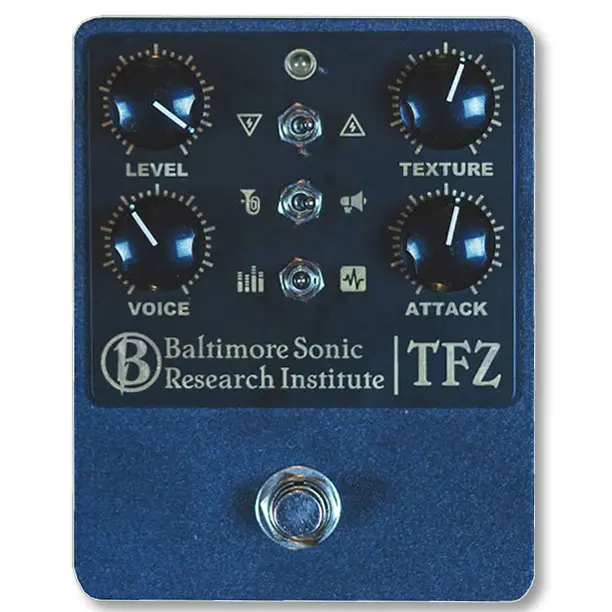
The TFZ is a vintage transistor-based fuzz by Baltimore Sonic Research Institute (aka BSRI), a company whose name sounds like some kind of government-supported facility, but that’s actually just one dude called David Gill who is into Doom Metal.
Rather, it’s more than a fuzz, since David wanted to create “a single pedal that could cover dirt tones ranging from overdrive through distortion and on into totally compressed splattery fuzz that has hints of octave, ghost tones, and surprisingly accurate horn emulation.”
He achieved this with a 4-knob and 3-toggle device, let’s check out what each control does: the knobs are pretty standard, with the exception of the Texture one:
Level = Output Volume
Attack = Gain
Texture: “Adjusts the voltage fed to a portion of the circuit to change both the dynamic range of the clipping amp and the character of the clipping.”
Voice = Tone control (low pass + high pass filter).
The switches deliver most of the pedal’s sonic range:
Voltage: “Sets the range of the Texture control. To the right lie punchier and clearer tones. To the left lie compressed, starved, and glitchy soundscapes.”
Tuba/Megaphone: Selects between two frequency ranges feeding the clipping circuit: Megaphone mode is tight and rather “normal,” while Tuba mode delivers, in conjunction with higher texture settings, a tone with horn overtones and suboctaves.
Clipping: Selects between three clipping voices that deliver a varying amount of overdrive or fuzz. Center position gives the cleanest and most dynamic range; left position delivers a higher-gain, smooth overdrive tone that can be thick and dense at lower texture settings The right position has the most distortion and can get downright weird in Tuba mode at low Texture settings.
Also, the BSRI Audio TFZ Fuzz has self-oscillating tendencies! Check out how it sounds in the video below.
OK maybe “The Ultimate Fuzz” is a bit of a stretch. But TFZ is definitely the ultimate fuzz for me and what I was looking for when designing it. I wanted a single pedal that could cover dirt tones ranging from overdrive through distortion and on into totally compressed splattery fuzz that has hints of octave, ghost tones, and surprisingly accurate horn emulation. There is dynamic analog dirt in the in between tones and, for the adventurous, absolute delight in the extremes. TFZ rewards the knob turner with an endless array of new tones from one pedal.
Let’s take a look at the controls:
Level – Sets the output volume. Ample boost above unity is available.
Attack – Sets the input gain of the circuit from light boost to heavy clipping
Texture – Adjusts the voltage fed to a portion of the circuit to change both the dynamic range of the clipping amp and the character of the clipping.
Voice – Tilt EQ control that combines a low pass and high pass filter for frequency compensation.
Switches (top to bottom)
Voltage – Sets the range of the Texture control. To the right lie punchier and clearer tones. To the left lie compressed, starved, and glitchy soundscapes.
Tuba/Megaphone – Selects between two frequency ranges feeding the clipping circuit which completely alter the feel and response of the pedal. Megaphone stays tight and guitar-like. When combined with low Texture settings, Tuba delivers horn sounds and suboctaves in parallel with the note played. Heavily interactive with the Clipping switch and Attack and Texture controls.
Clipping – Selects between three clipping configurations to define the overall amount of overdrive or fuzz. Think of this as three channels for any given setting on the pedal. Center will be the least clipping and most dynamic range where overdrive sounds are thick and plentiful. To the left you’ll find more clipping and also a smoother overdrive tone that becomes thick and dense when rolling back the texture knob for some sag. To the right is the most distortion and the weirder sounds in the pedal if used with the Tuba switch and low Texture settings.
Note – Some combinations of settings may cause oscillation. Raising the Attack control setting will usually retain the sound you had while cutting off the oscillation. Or maybe you like the oscillation. Do you!
TFZ is unique among BSRI Audio products in using vintage transistors to achieve its complex blend of tones. When I was working on this circuit I spent months sorting through everything I have in my shop and seeking out just the right parts sourced from around the world to make it sound exactly how I wanted. The parts aren’t ‘magic’ or anything like that. They’re just tested and selected for each unit to do exactly what they’re supposed to do. It takes a little extra time, but for this circuit, its worth the effort.






















